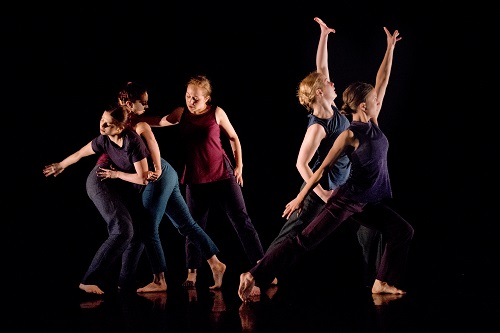 United Kingdom Dodds, Sheen, Zhao, Borin, Huelin, Music Collaborations: London Contemporary Dance School/Guildhall School of Music and Drama, The Place, London, 4.12.2015. (J.O’D)
United Kingdom Dodds, Sheen, Zhao, Borin, Huelin, Music Collaborations: London Contemporary Dance School/Guildhall School of Music and Drama, The Place, London, 4.12.2015. (J.O’D)

Friends Minus Two
Dancers: Ricky Lee Huxstep, Madeleine Jonsson, Margarida Macieira, Ellyssa Tilles & Nicholas Temple (performer)
Choreographer: Yue Tong Kwan
Composer: Cameron Dodds
Ominous
Dancers: Katy Ayling, Jade Brider, Eleonara Ramsby Herrera, Clara Rust, Ellyssa Tilles
Choreographer: Waddah Sinada in collaboration with the dancers
Composer: Jack Sheen
Constellations
Dancers: Katy Ayling, Amy Chihara, Charlotte Hilton, Ricky Lee Huxstep, Madeleine Jonsson
Musicians: Patrycja Mynarska – violin; Yi-Ning Liao – violin; Timothy Lin – violin; Agata Mierzwińska – piano; Rodrigo Viterbo – didgeridoo
Personae
Dancers: Amy Chihara, Charlotte Hilton, Kellie Jones, Clara Rust
Musicians: Joshua Borin – bass clarinet; Marta Puig – piano; Meritxell Brugué Noguer – piano
Choreographer: Jamie Chapman
Composer: Joshua Borin
Another Way of Talking
Dancers: Jade Brider, Kellie Jones, Margarida Macieira
Musicians: David Råberg-Schrello – cello; Katy Reader – cello
Choreographer: Maeve McGreevy
Composer: Toby Huelin
It is a musician who first appears to begin this programme of five, short collaborations between students of the London Contemporary Dance School and student composers at the Guildhall School of Music and Drama. Wearing what looks like a lab coat, a fair-haired young man steps through a door at the back of the stage to stand behind an upright piano on which two laptop computers lie open.
The positions of the four dancers at the start of Friends Minus Two may be a reference to the nymphs and the faun in Nijinsky’s L’Après-midi d’un faune. This impression is reinforced when the man begins a sideways walk towards the three women. But the walk is in slow motion, and the man’s face is turned towards the audience with a fixed stare. As the piece continues bodies and facial expressions continue to perplex. Undulating stomachs are rubbed. Heads are held exaggeratedly to one side. Smiles mean anything, or nothing. The voices of dancers and musician produce sounds such as ‘Vroom!’, ‘Cuckoo!’ and a slow, hissing ‘Shuuush!’.
The music for Ominous, ‘made entirely out of percussion’, is recorded. It builds to a climax as five women in clothes of purple, dark green and black move as a group in light that comes and goes. That they are women is a detail. For they move in ways more often associated with male dancers. It isn’t that one of them is lifted by the others. It isn’t that they grimace and snarl. It is the way they hold their bare arms and shoulders in relation to their torsos.
The cello and two violins played by the on-stage musicians of Constellations produce an almost physical warmth as they, a piano and a didgeridoo, provide momentum for four women and one man to run in wide, clockwise and anti-clockwise circles. With a debt perhaps to Anne Teresa De Keersmaeker’s Vortex Temporum, which was performed at Sadler’s Wells last May, the piece sets its dancers running and jumping and spinning in a choreographic language that is clear, simple and, in the last instance, tender.
Piano and bass clarinet produce sounds of a more menacing quality in Personae. Its four dancers are first seen in hooded robes and with their backs to the audience. Movement begins with the hoods being pushed back and the lower folds of the robes gently lifted and held out against the light for a moment before being allowed to fall. When the robes are discarded, the dancers move with something of the ‘masculine’ quality of Ominous: agitated spins and lifts. The piece ends with all four, shaking their shoulders in a tightly-knit group.
If the musicians in the preceding works are discreetly at the sides and back of the stage, Another Way of Talking puts them towards the front and in the middle. Two cellists in black sit on chairs placed one behind the other in a diagonal line and at an identical angle to the audience. The lace on the upper parts of the woman’s dress echoes that on the black costumes of two of the three, female dancers who stand near them.
As the cellists begin a speechless dialogue across the space between them, the dancers launch into repeated sequences of movement that are individual to each. One stops in a stately walk to rise on to her toes while keeping head and shoulders bowed, arms pointing stiffly downwards. Another flicks her wrists. The third performs a quirky arabesque, and little, shuffling steps, also on her toes. It is the piece in which music and dance most obviously merge.
John O’Dwyer